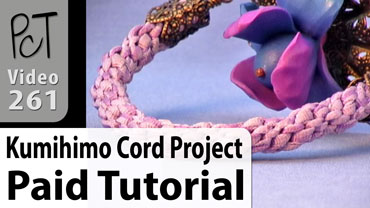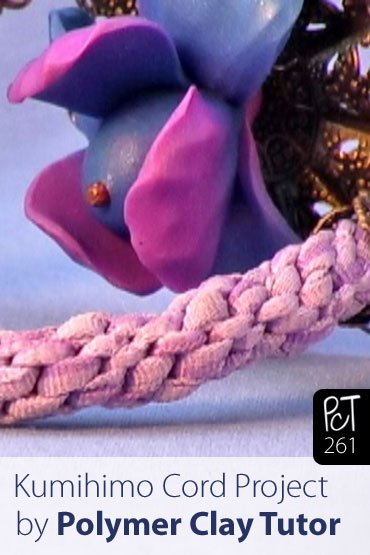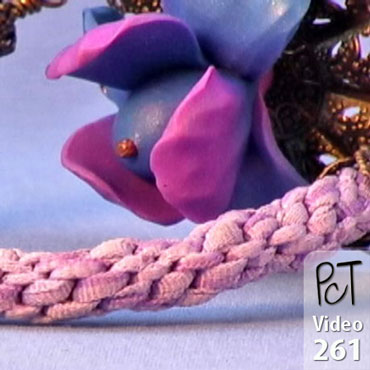Vol-049-4 Kumihimo Cord PcT Tutorial (Intro)
Video #261: “The Japanese braids look like they’d pair perfectly with polymer pendants.” ~Phaedrakat
More...
** This post is an introduction to one of our paid tutorials.
Once you have learned to make some beautiful polymer clay pendants and beads, you’re going to have to put them on something, right? Why not make your own custom braided cording, Japanese style!
Kumihimo is an ancient Japanese Braiding technique, traditionally done on beautiful round wooden stands that are used while sitting on the floor. There are many different styles and patterns of Kumihimo Braids, typically created using fine silk cording or thread.
As with many traditional handcrafts, modern supplies and materials can make it possible for the average person to do these ancient crafts. Here is a YouTube video that introduces the Kumihimo equipment used for higher volume production:
You may have started to see foam Kumihimo Disks and Plates, as well as books, findings, cords and other braiding supplies, popping up in your local craft shops and bead stores. These new braiding ‘looms’ have made it possible to learn how to make Kumihimo Cords quickly, easily and very inexpensively. Plus, with the amazing variety of patterns and possible fibers/materials that you can use in Kumihimo cords, the possibilities are astounding!
“The Japanese braids look like they’d pair perfectly with polymer pendants. Have you been doing that? Seems like you could match your clay to your fibers, and end up with some gorgeous pieces! Even a very simple pendant would look spectacular on one of those braided chokers. You know, I love fibers and things, too. I’ve never tried anything like Japanese braiding, but I bet I would love it. I learned to sew at a young age, and always “collected” bits of fabric, yarns, strings – anything that felt nice that I thought I could do something with. Does it take a long time to learn? It looks like it takes SKILLS!” ~Phaedrakat
Now, I have only been making these cords for a short while, so I am not claiming to be an expert in Kumihimo techniques. But since I had a heck of a time figuring out the instructions that were printed on the card that came with my Kumihimo Foam Disks, I thought you may appreciate learning the shortcuts and techniques I figured out, during my learning curve on the subject.
“
My Kumihimo cords turned out great. I am making some in blues to hold Mokume Gane wood grained lentils. I showed the cord technique to a friend, she loved it and has learned how to make them following your instructions! It is amazing how far reaching your tutorials have become!
Dixie Ann S
“
Cindy, this tute is perfect! I made some kaleidoscope beads and I've been wracking my brain trying to figure out how I could make my necklace cords more sophisticated to match the pendants. I ordered the discs the day the tute came out and I'm on my third necklace now.
Carrie N
“
Hi Cindy - I just taught my grand daughters how to do the Kumihimo cord technique. Thank you for showing me so clearly how to do the Kumihimo cord work... so I could teach it to them. They love this as much as they love working with me using polymer clay. Thanks!
Natalie H
Transcript coming soon...
Transcript coming soon...
Our goal is to translate these videos into as many languages as possible. If you are interested in helping with this initiative, then please do contact us and we will figure out a way to make it worth your while :)
Shareable Images



Want to chat about today’s post? That’s what the comment section below is for. Scroll Down… We’d love to hear from you!
Or... if you would like to request a topic for a future post, here is the link to do that… PcT Suggestion Box


In making the Kumihimo cord i saw where lace can be uses and ribbon. I have a huge bag full from other projects do you use a certaIn width or cut the laGer widths ?
You can use larger ribbon no problem Mikki, it just kind of bunches together to make a thicker cord. Just try it. Each material will look different. You can get some interesting effects if you mix different widths in the same cord. Skinnier cords tend to draw nearer to the center and the wider ones tend to pop out to the outside. Play with what you’ve got. If it doesn’t look good, you can always undo it and try something else. Have fun and make sure to post pics of your experiments on our Facebook Page!
Cindy, I took a class a couple of years ago to make a beaded Kumihimo bracelet. I had a terrible time getting the beads to stay in the right spot, so I never did finish. I blame it on using embroidery floss, which was too fine and limp for the beads, and for not using a weight. I wanted to try it again without the beads. The next time I used some C-Lon thread that was leftover from another project and my results were just OK–it’s very hard to keep the tension without a weight–and I thought the result was a little stiff. Unfortunately, there’s nowhere to buy nice cord near me. I never thought of ribbon!
After watching your tutorial I went out and bought several spools of the 50 cent ribbon at Michaels and they worked really well. I also ran with your idea for the weight. What a difference that made, not only in the ease of working the cord, but in the even look of the braided cord.
So thanks again, Cindy. The things I learned in your tutorial brought me from failure to success!
Linda I am sorry I didn’t respond to this kind comment until now. I meant to but got distracted by all that is going on around here and forgot (We are getting the Roadtrip plans underway and there is so much to do for that.) I am so glad you found success finally with the Kumihimo. I had seen a woman using keys for a weight years ago, way before I had even started making the cords. I promptly forgot and when I did start making cords I struggled away trying to make them without one. Then eventually the memory came to the surface again… I then experimented with the different charms until something worked. Made a big difference for me and looks like you too! :) I have not yet worked with beaded kumihimo. Will try that next. They really are so beautiful and make a fantastic compliment to our polymer clay pieces.